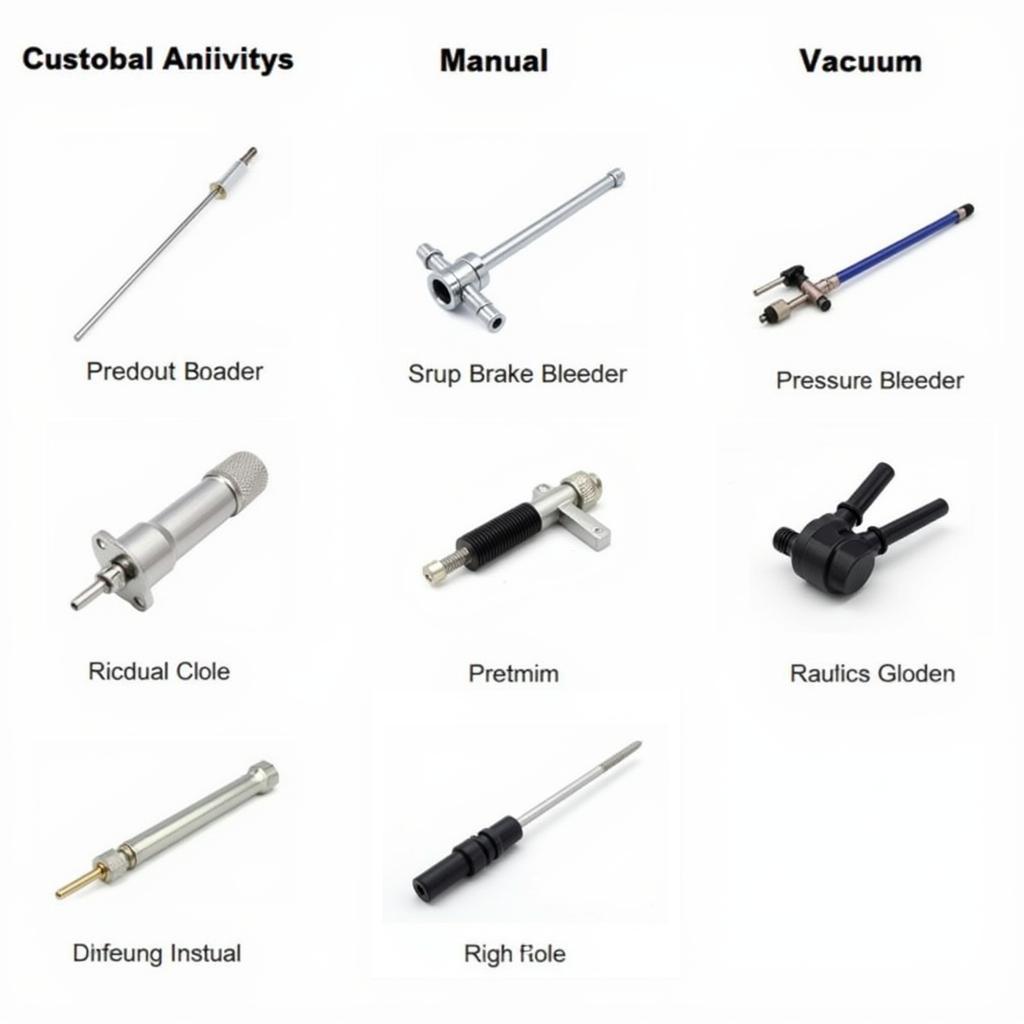A Car Brake Bleeder Tool is essential for any DIY mechanic or professional looking to maintain their vehicle’s braking system. Whether you’re flushing old brake fluid or replacing brake components, using the right bleeder tool ensures a safe and effective brake bleed. This article will guide you through the different types of car brake bleeder tools, their benefits, and how to choose the best one for your needs. Let’s dive in!
 Different Types of Car Brake Bleeder Tools
Different Types of Car Brake Bleeder Tools
Understanding the Importance of Brake Bleeding
Why is brake bleeding so crucial? Over time, brake fluid absorbs moisture from the air, which can lower its boiling point and lead to brake fade. Air can also enter the brake lines, causing a spongy brake pedal feel and reduced braking power. Bleeding your brakes removes both air and old fluid, restoring optimal braking performance and ensuring your safety on the road.
 Brake Bleeding Process Demonstration
Brake Bleeding Process Demonstration
Types of Car Brake Bleeder Tools
Several types of car brake bleeder tools are available, each with its advantages and disadvantages. Choosing the right tool depends on your budget, skill level, and frequency of use. Some mechanics prefer the simplicity of a manual bleeder, while others appreciate the speed and efficiency of a pressure or vacuum bleeder. You can find many of these essential tools if you are thinking, “What tools do I need to work on cars?”
Manual Bleeder Tools
Manual bleeders are the most basic and affordable option. They require a second person to pump the brake pedal while you open and close the bleeder valve. While effective, this method can be time-consuming and physically demanding.
Vacuum Bleeder Tools
Vacuum bleeders use a hand-pump or electric pump to create suction, drawing the old brake fluid and air out of the brake lines. These tools are faster and easier to use than manual bleeders, but they can be more expensive.
Pressure Bleeder Tools
Pressure bleeders force new brake fluid through the brake system, pushing out the old fluid and air. They are the most efficient option, especially for professional mechanics, but they also come with the highest price tag. If you are looking for other important car tools this might be it!
 Comparison of Manual, Vacuum, and Pressure Bleeders
Comparison of Manual, Vacuum, and Pressure Bleeders
How to Choose the Best Car Brake Bleeder Tool
When choosing a car brake bleeder tool, consider the following factors:
- Budget: Manual bleeders are the most affordable, while pressure bleeders are the most expensive.
- Skill level: Manual bleeders require some coordination with a helper, while vacuum and pressure bleeders are easier to use solo.
- Frequency of use: If you only bleed your brakes occasionally, a manual bleeder may suffice. For frequent use, a vacuum or pressure bleeder is a worthwhile investment. It could be you are just looking for car brake repair tool.
- Vehicle type: Some vehicles may require specific adapter fittings for certain bleeder tools.
What are the best car brake bleeder tools?
This depends on your budget and needs, but some popular and effective options include Motive Products Power Bleeder, Mityvac MV8500, and Astro Pneumatic 7832.
Can I bleed my car brakes myself?
Yes, with the right tools and careful attention to instructions, bleeding car brakes is a DIY-able task. However, if you are uncomfortable working on your brakes, it’s always best to consult a professional. Maybe car repair tool hire is best for you?
Conclusion
Choosing the right car brake bleeder tool is crucial for maintaining your vehicle’s braking system and ensuring your safety on the road. By understanding the different types of bleeders and considering your individual needs, you can make an informed decision and invest in a tool that will provide years of reliable service. For information on where you can rent car tools uk we have it covered.
FAQ
- How often should I bleed my brakes? It’s generally recommended to bleed your brakes every two years or 24,000 miles, or as recommended by your vehicle’s manufacturer.
- What type of brake fluid should I use? Always use the brake fluid recommended by your vehicle’s manufacturer. Using the wrong type of fluid can damage your braking system.
- What are the signs that my brakes need bleeding? Signs include a spongy brake pedal, reduced braking power, and a longer stopping distance.
- Can I use a car brake bleeder tool on a motorcycle? Yes, but you may need specific adapter fittings.
- Is it dangerous to bleed my brakes myself? Not if you follow the proper procedures and safety precautions. However, if you are unsure, it’s always best to consult a professional.
- What happens if I don’t bleed my brakes? Over time, air and moisture in the brake fluid can lead to brake failure, which can be extremely dangerous.
- Can I mix different types of brake fluid? No, mixing different brake fluids can damage your braking system.
Common Scenarios
- Scenario 1: You notice your brake pedal feels spongy. This is a common indicator of air in the brake lines and necessitates bleeding.
- Scenario 2: You are performing routine maintenance and want to replace your old brake fluid. This is a perfect opportunity to use a car brake bleeder tool.
- Scenario 3: You have recently replaced a brake component, such as a caliper or brake line. This requires bleeding the brakes to remove any introduced air.
Further Exploration
Consider exploring other articles related to car maintenance, such as “Changing Your Brake Pads” or “Understanding Your Car’s Braking System.”
Contact Us
For any further assistance or inquiries, feel free to reach out to us via WhatsApp: +1(641)206-8880, Email: [email protected] or visit us at 910 Cedar Lane, Chicago, IL 60605, USA. Our customer support team is available 24/7.

Leave a Reply